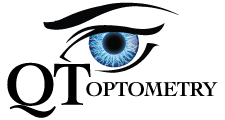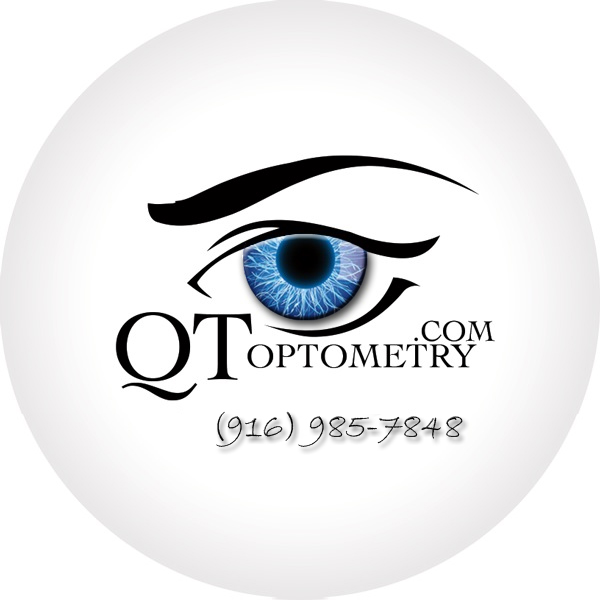Orthokeratology Therapy, Ortho-K, or CRT
Welcome to QT Optometry’s Orthokeratology Therapy, our Custom Corneal Reshape/Refractive Therapy Program. You are beginning an exciting program designed to reduce and/or eliminate your dependency on eyeglasses and/or soft contact lenses during the day! The process reduces your refractive errors by wearing a Custom Corneal Molded retainer, which will gently and non-surgically reshape your corneas as you sleep! This can be achieved if you think of the cornea as the eye’s equivalency of a watch crystal. It is a clear, dome shaped structure that overlies the colored iris. The corneal tissues are most similar to clear, wet skin; and just like your skin, it is very pliable. Because the cornea separates the eye from air and the rest of the outside world and because it has a curvature that bends light towards the back of the eye, it is responsible for most of the eye’s corrective power and thus contributes to various conditions, such as nearsightedness (myopia), farsightedness (hyperopia), and the blur of astigmatism!

US Food and Drug Administration (FDA) Approval: There are several Orthokeratology Lens Designs on the market. Some of the Designs have specific FDA approval and some do not. The US Food and Drug Administration have determined that Orthokeratology Therapy is a safe and effective procedure and have approved several lens manufacturers’ designs. The FDA only approves lens that have a fixed set of curvatures and diameters to treat myopia (nearsightedness), hyperopia (farsightedness), and astigmatism, in the ranges of -0.25 to -6.00 and -0.25 to -4.00 respectively. However, most designs are customizable, and allow us to use multiple curves, which are measured in microns. While technically this means that our designs may not be FDA approved, it is a legal, off label use of the materials and designs. Dr. Q feels that with this freedom of customization, in the hands of a skilled Orthokeratologist, is the best method to obtain clear, consistent, and comfortable vision.
Contraindications: The following conditions present a reason NOT to undergo Orthokeratology Therapy (Corneal Molding Treatment). By initializing, you certify that you do not have any of the following:
- Keratoconus.
- Corneal Dystrophy.
- Corneal Degeneration/Disease.
- Previous History of Ocular Herpes Infections, Pregnancy (or planning on becoming pregnant within the next twelve (12) months).
Limitations:
- Out of Range Prescriptions: Prescriptions exceeding the normal range of Corneal Molding may take longer to mold, and therefore, longer to achieve ideal vision. It IS possible that full correction may not be able to be achieved. A ‘skinny’ pair of glasses may be worn to help night vision or computer vision in these cases.
- Resistant Cornea: Some corneas will not mold. Prior to beginning the Therapy process, we will be performing tests to rule out known causes for a non – responsive cornea.
- Insufficient Therapy Time: Some patients cannot sleep for the minimum 6 hours per night; the requirement for optimal Therapy. This may limit our ability to mold the cornea. Full Therapy may not be achieved in these cases.
- Permanent Vision Correction: Corneal Molding will NOT give permanent corrective vision.
*Your prescription may revert to its original shape, if your Therapy is terminated, for any reason*
Risks And Complications
Lens Awareness: The lenses may feel scratchy, if they are worn during waking hours. (They are designed for closed eye wear.) With time, this scratchiness will usually lessen. However, we advise minimizing your use of the lenses during waking hours as this may compromise your Therapy (the Treatment Zone).
Initial Blurriness: During the first week, Therapy Molding may be incomplete, and you may experience some blurred vision. We will provide you with a series of disposable soft lenses to be used until you feel your vision during the day hours are clear, consistent, and comfortable.
Over or Under Corrections: In most cases, the initial Custom Corneal Molded lenses will achieve optimal vision. On occasions, over or under Therapy may occur. New lenses will be ordered to correct this problem. If new lenses cannot achieve optimal Therapy, eyeglasses may be prescribed for part time wear. These glasses are NOT part of the Fees for the Corneal Molding Procedure.
Halos: Some Patients may experience halos or flare around lights at night. This usually becomes less noticeable within a few weeks. If it does not subside, we will attempt to re – design the lenses, to create a larger Treatment Zone/Area, or the use of medicated eye drops may help. However, in some cases, these halos may NOT completely disappear.
Infections: The risk of infection while wearing Custom Corneal Molded lenses are very rare. However, there is a slight risk of an infection caused by an amoeba (bacteria found in tap water). We have designed a lens sterilization program that eliminates this risk and you will receive extensive training in the care of your Custom Corneal Molded Lenses. Under NO circumstances should you rinse your lenses with tap water or to modify your sterilization regimen without consulting with Dr. Q. Serious infection can occur and may result in corneal scarring, which can lead to a permanent reduction of vision, and/or even a complete loss of vision (blindness).
Abrasions: At some point, you may experience a superficial abrasion to the cornea. This can occur if:
- debris gets trapped between the eye (cornea) and the Mold,
- the Mold was not cleaned properly or disinfectant was not rinsed from the Mold,
- you slept with your eye slightly open. These are rare, and are temporary. Please call the office or Dr. Q, if you wake up with a painful or red eye that does not resolve within 30 minutes.
Dry Eye: Some people do not produce sufficient tears. We will perform tests to determine your tear quantity and quality. If dry eyes are diagnosed prior to treatment, we will not start the program until the problem has been resolved. If the molding process results in dry eyes, lenses may need to be discontinued while the problem is being solved. Please inquire with Dr. Q for some causes and/or signs/symptoms of dry eyes.
Advantages and Disadvantages
Advantages of Orthokeratology: Some advantages of Orthokeratology Therapy includes its inherent ability to non – surgically and reversibly changes the shape of the cornea, to compensate, and correct for your refractive status. Orthokeratology enables the freedom from constantly wearing some form of corrections, which may include glasses, soft contact lenses, or even gas permeable contact lenses. It is a good alternative to surgery, and is usually ideal for people whose lifestyles do not promote the wearing of normal contact lenses. Orthokeratology Therapy is available for most people, including adults as well as children. More importantly, within the Pediatric population, it serves as a way to reduce the progression of myopia (nearsightedness).
Disadvantages of Orthokeratology: Some disadvantages of Orthokeratology include a much longer time requirements, in order to achieve your ultimate goals. Furthermore, Orthokeratology Therapy is NOT a permanent solution. Rather, if you decide to stop the Therapy, for whatever reason, your cornea will revert back to its original, pre – therapy shape, pre – therapy refractive status, as well as its pre – therapy rate of myopia (nearsightedness) progression. Lastly, Orthokeratology Therapy does have a higher start – up cost than “regular” contact lenses or eyeglasses.
Expectations During the First Month: During the first month of wearing the lens, when the treatment zone on the surface of the cornea is in the process of becoming fully formed, some users may experience vision issues such as ghosting, double vision, contrast problems, and/or star bursting, especially at night. These issues are generally resolved by the end of the first month of lens wear. If these issues persist beyond this initial period, the cause may be due to lack of centration of the lens on the eye and/or overly large pupil size (in light or dark). Typically, complications can occur due to the patient’s failure to follow appropriate hygiene recommendations when handling or cleaning the lenses including the use of tap water to rinse (although some systems allow for or suggest the use of “clean” tap water) or store. Complications may also be due to relative corneal hypoxia (lack of oxygen) with prolonged or overnight contact lens wear in lenses made from the wrong material. The use of high or hyper oxygen – permeable materials has been approved by the US Food and Drug Administration and is being manufactured by leading contact lens companies such as Bausch and Lomb and Paragon Vision Science, has significantly reduced hypoxia, and these are the materials that are normally used in the Orthokeratology Therapy lenses.
Regression: Custom Corneal Molding attempts to slow or stop the progression of myopia (nearsightedness). Nevertheless, regression of Therapy may occur at some point. This may require a re – designing of the lenses to again achieve optimal vision. It is impossible to list every conceivable complication that could occur with Orthokeratology (Custom Corneal Molding). Complications that are considered to be unforeseeable or unknown at this time are not discussed.



